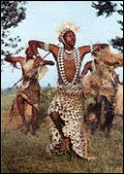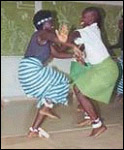 Intore
Dance of Peace Intore
Dance of Peace |
The male dance, known as Intore in the Kinyarwanda
language, were traditionally warriors.
The females' dance, on the other hand, is often
compared to ballet. It is meant to show the grace
and beauty of Rwandan women as well as emulating
cattle's movement. Cattle is a form of wealth in
Rwandan and Burundian culture.

Rwandan dancing was first introduced to the American
public through the movie "King Solomon's Mines"
(1950). Soon after, a dance craze called
"The Watusi" loosely based on the Intore
swept America. |
Rwandan dancing, however,
is performed by all three of Rwanda's ethnic groups:
Hutu, Tutsi and Twa.

From the Ikinimba through the Imishayayo to the
Intore, men dance to show courage and authority,
while women dance to show love and care.
Ikinimba is part of the traditional courtship ritual.
It is danced by men and unmarried women.
When a woman marries, she may no longer participate
in the dance, but men may perform the dance after
they are married. |

